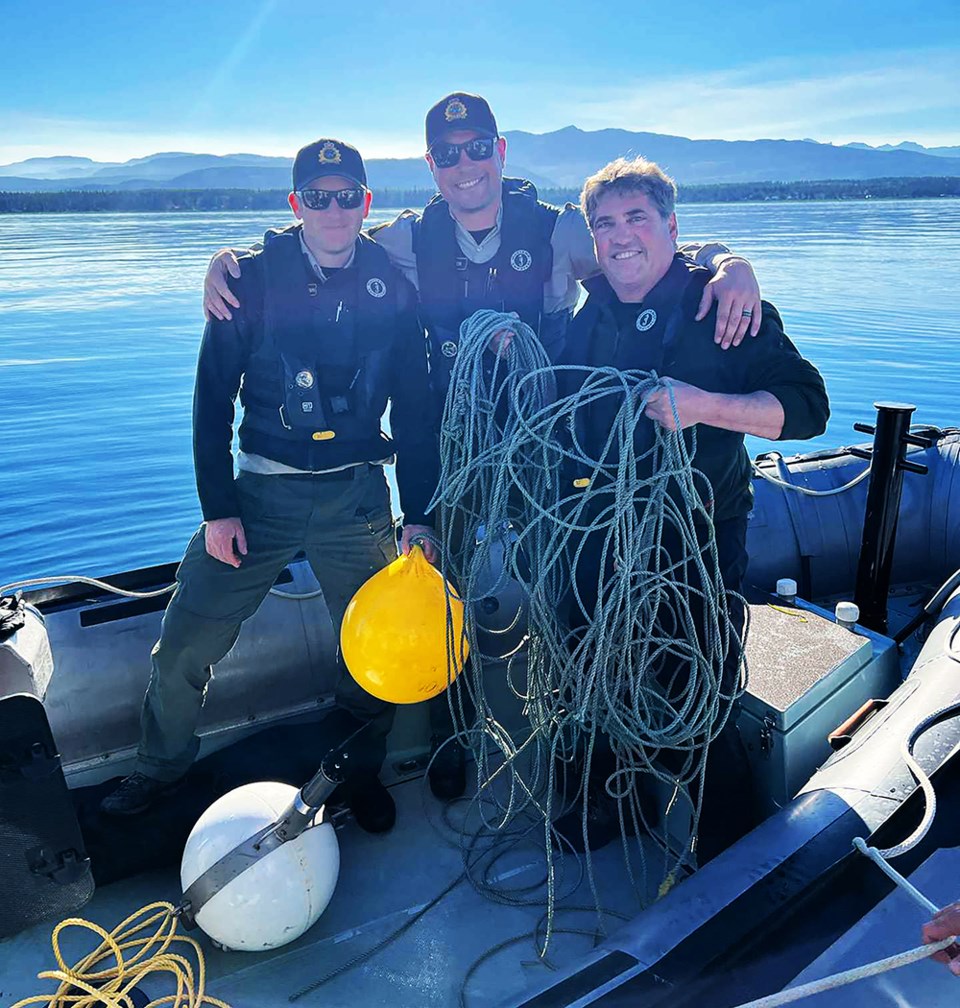A two-day operation in local waters to free a humpback whale of gear from recreational prawn fishing resulted in the whale swimming free.
The search for the whale started on October 13 after a report from a tugboat operator that there was a whale towing around a big yellow buoy and a bunch of rope south of Thormanby Island, off the lower Sunshine Coast, according to Powell River fishery officer Ben Rahier. Rahier said he and fishery officer Bill van Egteren headed down in the fisheries boat to have a look.
“While we were searching around down there, we were assessing different humpbacks and killer whales, looking for gear,” said Rahier. “We received another call that a whale towing a yellow float was actually in front of Nanaimo. We went over there and we had an RCMP vessel, we had coast guard, and we had a bunch of folks on the water trying to track this whale down, but we weren’t able to find it.
“Conditions were tough and there were a lot of whales in the area. We looked everywhere and couldn’t locate the whale.”
Rahier said as soon as the crew was pulling the boat out of the water, another call came in from another tugboat operator near Lasqueti Island, in the southern Texada Island area, where there was a whale towing a yellow float. He said, however, that the fishery officers were not able to track down the whale that day.
In the morning of October 14, another report was made by a whale-watching vessel, between Savannah Point on Texada Island and Cape Lazo in Comox. He said there were two whales, one of which was towing a yellow buoy attached to a bunch of rope.
“We headed out from Powell River to the west side of Texada Island,” said Rahier. “The whale-watching vessel was able to stay on station. We got on it right away, and as per our training, we have a satellite tracking tag that is affixed to a buoy on a length of rope.
“The first thing we wanted to do is attach that tracking buoy to whatever gear attached to the whale so we didn’t lose the whale again.”
Rahier said he was operating the vessel and on almost the first try, they were able to affix the satellite tag and get it deployed. He said it was a complicated operation, given that the whale was moving at five to seven knots; there was another whale in the vicinity.
Team effort
Once that operation was concluded, regional marine mammal response coordinator Paul Cottrell, in another vessel with his assistant, went in to disentangle the whale from the rope. Rahier said he remained on station as the rescue vessel.
There was also a support vessel from the Lower Mainland on station, which operated a drone, to provide real time footage on how the whale was entangled, as well as the whale’s movements.
“The whale had a string of recreational prawn gear through its mouth,” said Rahier. “One side of the whale was pulling the traps and the line went through its mouth and back around to the buoy. We were able to hook onto the trap side and essentially work our way up, cutting as we went and bringing it into the vessel. We would have to wait for the whale to settle after reacting to our work and then go back in and try to cut more rope, the goal being cutting the rope as far up to the mouth as possible.
“On the other side, which was trailing the yellow float, as well as our satellite tag, we attached multiple big floats to create drag. You want that other side with the floats to have as much drag as possible in the hope that the line will be pulled out of the whale’s mouth.”
Rahier said the whale eventually ended up breaching, almost doing a backflip, and in doing so, with the drag from the extra buoys, the rope dislodged.
“The whale swam off with its companions,” said Rahier. “It was a really positive experience. It sounds like a simple process but I think it took us more than five hours to get to the point where we were attaching the other buoys to pull the rope out of the whale’s mouth. It was a lengthy process.
“Being the vessel operator, there are potential dangers, weaving among the whales. It was a matter of keeping the crew safe and making sure the line did not end up in the propeller. Worst case scenario is being towed by a whale.”
Rahier characterized the operation as a success and it appears there was no permanent harm done to the whale. He said having the rope through the whale’s mouth makes it a challenge for the whale to feed and go through its regular life processes. He said such entanglements generally lead to death if not cleared.
Rahier said a big shout-out goes to the vessel operators who called it in.
“If we didn’t have all of those eyes on the water calling in the location of the whale, it would have been really difficult to track it down and disentangle it like we did,” said Rahier. “We always encourage people to report any marine animal in distress, especially entangled whales, by calling the marine mammal incident reporting hotline.”
The number is 1.800.465.4336.



